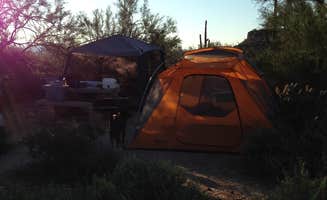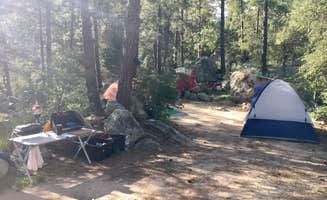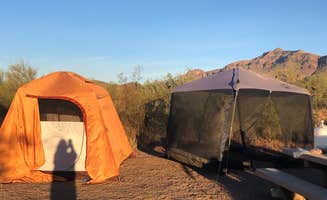Tent camping in Phoenix, Arizona offers a varied landscape of desert terrain with elevations ranging from 1,100 to 7,000 feet across different sites. The Sonoran Desert features unique ecological zones where campers encounter saguaro forests, mesquite woodlands, and desert riparian areas. Winter temperatures typically range from 40-70°F, making November through April the primary camping season in this region.
What to do
Mountain biking from camp: At McDowell Regional Park-Ironwood, trails start right from your site. "Excellent mountain biking and hiking trails right out of the campground," notes Jeff B., who appreciates the direct trail access despite the lack of showers at this tent-focused area.
Off-road adventures: The area north of Phoenix offers extensive off-road opportunities. "Miles of desert and washes to explore with tons of dispersed camping sites," reports Caitlin S. about Boulders OHV Area. The nearby washes lead to trails near Castle Hot Springs and various abandoned mine sites.
Stargazing: Dark skies are a major draw at several remote sites. At Peralta Regional Park, one camper describes "Clean dark sky for star watching" as a highlight of their experience. The mountains block light pollution from Phoenix, creating prime conditions for viewing constellations and meteor showers during winter months.
Fishing desert lakes: Some camping areas provide water access in this arid region. The Point Campground, accessible by boat, sits near a lake stocked with multiple fish species. About 2 miles upriver from Mormon Flat Dam, this area offers opportunities to spot desert wildlife, including "lots of birds and Big Horned Sheep as you paddle/boat up river."
What campers like
Elevation escapes: Crown King Area provides relief from summer heat at approximately 6,000 feet elevation. "Escape the desert heat," says Matt M., while another camper describes winter camping where "everything was covered in snow and just breath taking."
Desert solitude: Many dispersed sites offer isolation despite proximity to the metro area. At Margies Cove West Campground, campers appreciate the ability to "distance yourself as far as you want from any human being" with minimal traffic—"maybe five or six vehicles in any 24 hour period."
Wildlife viewing: The desert environment around Phoenix supports diverse wildlife. One camper at Hackamore Road reported, "The coyotes started howling around 4am, but they started dying down after they had migrated." Desert camping offers opportunities to observe reptiles, birds of prey, and mammals particularly active during dawn and dusk hours.
Easy access to amenities: Several camping areas maintain proximity to supplies while feeling remote. Crown King has "a general store with essentials and a 1 pump fuel station," though prices run higher than in Phoenix. The town also features dining options including "great food and drinks at the crown king saloon and Mimi's Cafe."
What you should know
Road conditions vary dramatically: Many dispersed sites require high-clearance vehicles. At Hackamore Road Dispersed, a camper warns "Hackamore Road is a straight up OHV Trail," while another advises "Roads are a little rough, just take it slow." Some roads are impassable for RVs without significant clearance.
Weather considerations: Temperature fluctuations between day and night can exceed 30°F. One camper at Boulders OHV Area notes it's "Obviously not ideal camping in the summer but GREAT for the fall/winter/spring months." Winter nights at higher elevations can drop below freezing, requiring appropriate cold-weather gear.
Insect activity: Several camping areas experience seasonal insect populations. At Margies Cove, campers report significant fly activity: "A lot more flies than I remember ever having been here before," attributing this to "a huge cattle stockyard about 2 miles from Woods Road."
Fire restrictions change frequently: Throughout the Phoenix region, fire regulations vary by season and jurisdiction. During high-risk periods (typically May through July), complete fire bans are common. Some areas permit fires year-round in established fire rings only, while others prohibit them entirely regardless of season.
Tips for camping with families
Choose established campgrounds for facilities: Peralta Regional Park offers a good balance of amenities and space for families. "Each campsite has plenty of space in between," notes one camper, who also mentioned that "Restrooms were great" and "The park host was amazing."
Watch for wildlife with children: Desert camping requires vigilance. A Peralta camper reports, "Came across a rattle snake when hiking," highlighting the importance of teaching children proper desert safety protocols, especially during warmer months when reptiles are most active.
Visit during wildflower season: For families interested in nature education, camping between February and April offers opportunities to observe desert blooms. The lower desert areas around Phoenix typically flower earlier than higher elevation sites, creating opportunities for sequential visits to different areas.
Pack extra water: The arid climate necessitates more water than camping in other environments. All dispersed sites lack potable water, and even established campgrounds may have limited access. Children typically need at least 2 quarts daily during moderate weather, more during warmer conditions.
Tips from RVers
Site selection for sun exposure: Position RVs strategically for comfort. At Boulders OHV Area, a camper notes "We liked it there. Nobody else on Friday night, plenty of space," but solar exposure can be intense. Facing doors east provides morning shade for afternoon comfort as temperatures rise.
Leveling challenges: The desert terrain creates unique parking situations. "The ground is hard as concrete," reports a Hackamore Road camper, which can make leveling blocks crucial for comfort, particularly for larger rigs at sites with natural slopes or uneven surfaces.
Cell service varies: Connectivity differs significantly between locations. A Boulders OHV camper reports "Service: 1 bar Verizon," highlighting the importance of downloading offline maps and information before traveling to more remote dispersed camping areas around Phoenix.
Road reconnaissance: For larger rigs, scouting roads before committing is essential. At Crown King, campers warn the access requires "a high clearance vehicle (4x4 highly recommended)" with "many areas that are only single vehicle width," making advance planning critical for safe travel with RVs.




